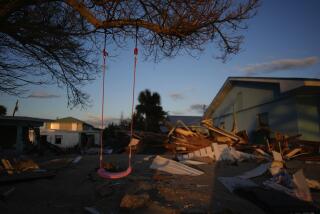Federal Disaster Relief Buoys Battered Florida : Hurricane: Local officials’ animosity fades as troops and supplies arrive. The toll of homeless rises to 250,000.
HOMESTEAD, Fla. — Battered South Florida dared to think about the future Friday as thousands left homeless by Hurricane Andrew welcomed the first of some 7,000 federal troops, 20 mobile field kitchens and dozens of truck convoys loaded with food, water, medicine and building materials.
As hundreds of people lined up for noontime meals of ham and eggs at four locations in this ravaged area, Dade County officials hiked the estimate of the number of homeless throughout South Florida to 250,000.
The death toll from the storm--called the most destructive natural disaster in U.S. history--rose to at least 28. Officials counted 24 dead in Florida, three in the Bahamas and one in Louisiana.
Wallace Stickney, administrator of the Federal Emergency Management Agency, Friday agreed with local officials that the damage inflicted by Andrew would reach $30 billion.
The arrival just after dawn of the first giant C-5 military transport plane, along with a convoy of 20 tractor-trailers packed with groceries, seemed to buoy spirits in Homestead, a city of 30,000, where at least 90% of the buildings have been destroyed or severely damaged.
“We’re a poor community, we have no electricity, and communication is a problem,” said Police Chief Curt Ivy, whose own home was virtually totaled by the storm. “There is going to be a lot of hardship. But help is here. I think we can rebuild.”
The massive federal response to the hurricane that began to make itself evident Friday seemed to end, at least temporarily, the acrimony expressed by many local officials who felt the Bush Administration, the American Red Cross and other agencies had not appreciated the extent of the catastrophe here.
“We Need Help” said the Miami Herald in a banner headline across Friday morning’s editions.
In Washington, a day after Dade County emergency services director Kate Hale blasted the federal response to the disaster here as too slow and plagued by politics, President Bush scrambled to head off political damage.
In a logistics account delivered to reporters in the Rose Garden before he left Washington for Camp David, Md., he announced that 7,000 federal troops had been deployed or were on their way to the South Florida area, and that they might be augmented by 1,000 Marines dispatched to Opa-Locka.
Bush said that two “tent cities” to house 5,000 people had arrived in Florida from the U.S. Navy base at Guantanamo, Cuba. He also said the Pentagon had delivered 200,000 meals, and another 200,000 would be delivered Friday and today.
Reading from a detailed listing of the federal government’s contributions, Bush said: “The military is sending a full medical brigade and seven special medical teams to deal with the health problems. Ten thousand gallons of bottled water arrived today. Contracts have been let for 6 million more gallons of water. Generators are being supplied for electricity support in relief centers. And in addition, the Army Corps of Engineers is on the ground to help with the removal of debris that will allow people to move around.”
“We did not anticipate the magnitude of the complete and utter destruction in the area south of Miami,” said Maj. Gen. John Heldstab, the Army director of military support.
Even as soldiers in Homestead set up the first of 20 mobile field kitchens--which eventually will be able to serve 72,000 hot meals a day--other supplies were arriving at a furious pace.
Most of the 4,500 federal troops on the ground by mid-day Friday flew into Opa-Locka Airport, north of Miami, and were trucked the 25 miles to Homestead. But at least two C-5 transports touched down at Homestead Air Force Base after its runway was cleared of debris.
Along with field kitchens, the military airlift was to bring in 400,000 MRE’s (Meals, Ready to Eat), 50,000 blankets, 25,000 cots and 1,250 tents. Many of the tents were to be erected near storm-blasted neighborhoods, where many residents who may have lost their own homes are squatting in those unoccupied houses that still have roofs.
Although the steady stream of supplies, citizen volunteers and emergency relief checks from both the Federal Emergency Management Agency and insurance adjusters have contributed to a tentative optimism, the task ahead is daunting. South of downtown Miami, through Kendall, Cutler Ridge and down to the end of the Florida peninsula, acres and acres of homes are roofless, windowless, powerless.
Many of those whose houses do have roofs have made them into blackboards turned toward Heaven. “Help!” they say.
Hundreds of homeowners have paused from scavenging for belongings to spray paint on a standing wall the names of their insurance companies and their policy numbers.
The federal troops sent to Florida join 3,000 Florida National Guardsmen ordered up by Gov. Lawton Chiles within hours of Hurricane Andrew’s landfall.
Hale, the Dade County emergency services director, who met here Friday with local and federal officials, again voiced her frustration over delays in getting supplies to the storm-dazed citizens earlier in the day.
“The President was here Monday; we should have had the supplies Tuesday,” she said. “It’s Friday and they’re just coming in.”
Hale did acknowledge that the appearance of Army troops “has already made a tremendous difference in morale. “It looks like we’re going to get the help we need,” she added.
She warned, however, that even as some people thought about rebuilding, search and rescue operations had not been completed in Dade’s hardest-hit areas.
Also Friday, active-duty troops evacuated from Homestead AFB were allowed to return to their homes for the first time since the storm’s 150-m.p.h. winds raked this largely-agricultural area early Monday.
“The base has been demolished. We’re just letting people look for what few precious possessions remain,” said Capt. Rick Sanford, a base spokesman.
There were not many. “I was stunned when I saw it,” said Airman Bonnie Stanley, who filled her Honda Civic with what clothing she could find in the rubble that was once her barracks.
Navy Capt. Bill Brinkman, 45, had a rental truck at the front door of what was once his four-bedroom base home. Assigned to Homestead just three weeks earlier, he weathered Andrew in a communications bunker in the Everglades. “What really strikes you afterward is what little value these possessions have,” he said, stacking wet books by the front door. “It’s people that make the difference.”
In Washington, the Air Force said it was temporarily relocating fighter squadrons attached to the base, but officials stressed that the relocations are temporary and no decision has been made on whether Homestead will reopen.
With a base population of 6,500 and home of the 31st Tactical Fighter Wing, Homestead narrowly escaped being closed earlier this year in wholesale Pentagon budget cutbacks. Now Andrew is likely to have done what the military chiefs avoided.
Most cement-block buildings have been gutted by the wind, their contents scattered. Overturned cars clutter parking lots and canals. The airfield control tower appears to be trashed, and two F-16 fighter jets--worth $16 million each but left in hangars on the base because they were not prepared for flying--sit ruined on a runway where Andrew deposited them.
In 90-degree heat and stifling humidity, people were pitching in all over south Dade County.
Under a lean-to tarpaulin in tiny Florida City, Gordon Chase was handing out baby formula, jars of strained carrots and diapers to mothers--many of them migrant workers. Chase and several other employees of Humana Hospital in Daytona Beach had arrived Thursday morning after a six-hour drive to volunteer their help. Why? he was asked. “Because we didn’t get hit by a hurricane,” he answered.
Terry Smith, 31, loading six bags of free ice into his car, said he was worried about whether Florida City, a hardscrabble farming town of some 4,000 residents, still existed at all. The debris of houses and windblown rubbish was everywhere.
“Friends of mine, people I’ve lived with for years, are leaving with relatives from Mississippi and South Carolina who come down here to pick them up,” said Smith, who works for the postal service. “That’s the worst thing for me--seeing friends leave. I think this place will be a ghost town.”
Times staff writers Rudy Abramson in Miami and James Gerstenzang in Washington also contributed to this story.
How to Aid Hurricane Victims
Relief agencies seeking donations to help victims of Hurricane Andrew:
Cash is being accepted by the American Red Cross, Disaster Relief Fund, P.O. Box 37243, Washington, D.C. 20013. For credit-card donations, telephone 1-800-842-2200. The Spanish-language number is 1-800-257-7575.
Disaster Response, Catholic Charities USA, 1731 King St., Suite 200, Alexandria, Va. 22314.
Church World Service, P.O. Box 968, Elkhart, Ind., 46515.
Presiding Bishop’s Fund for World Relief, the Episcopal Church Center, 815 Second Ave., New York, N.Y., 10017.
Caritas International Inc., P.O. Box 10-0179, Brooklyn, N.Y., 11210.
Donations to help animals left without adequate food and care can be sent to Zoo Crisis Fund, American Association of Zoological Parks and Aquariums, 7970-D Old Georgetown Road, Bethesda, Md., 20814.
More to Read
Sign up for Essential California
The most important California stories and recommendations in your inbox every morning.
You may occasionally receive promotional content from the Los Angeles Times.










